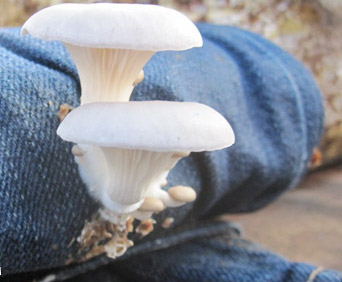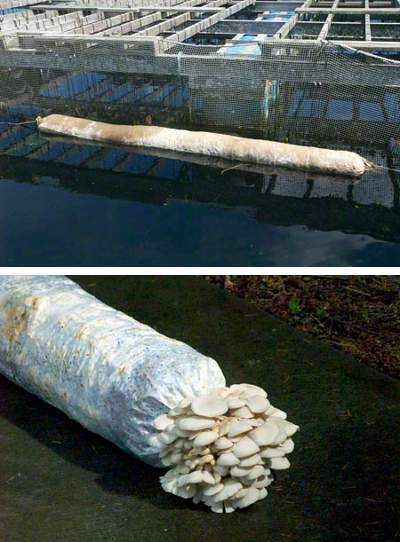
Mycoremediation
 Previously,
I've written about how we can grow mushrooms to eat, but mushrooms are
good for a lot of other purposes. For example, King
Stropharia
seems to attract worms, so the spent substrate is great fodder for the
worm bin. Other fungi in the soil team up with plant roots and
help them suck up water and hard-to-find nutrients. And now that
we've started terrorizing our landscape with toxic waste, scientists have discovered that fungi are even capable of cleaning up our messes --- mycoremediation.
Previously,
I've written about how we can grow mushrooms to eat, but mushrooms are
good for a lot of other purposes. For example, King
Stropharia
seems to attract worms, so the spent substrate is great fodder for the
worm bin. Other fungi in the soil team up with plant roots and
help them suck up water and hard-to-find nutrients. And now that
we've started terrorizing our landscape with toxic waste, scientists have discovered that fungi are even capable of cleaning up our messes --- mycoremediation.
Mushrooms are voracious,
and Tradd Cotter has found species that can chow down on E. coli and Salmonella,
suck up lead, mercury, arsenic and other heavy metals, and break down
chemicals into non-toxic compounds. The trick to using mushrooms
to deal with these contaminants is to find the right species for your
problem. For example, morels and puffballs are great at absorbing
heavy metals, but they won't touch coliform bacteria with a ten foot
pole. Luckily, King Stropharia and turkey tails fill that
niche. Oyster mushrooms can break down 80% of DDT in 28 days and
the aptly named "Train Wrecker" fungus can eat through railroad ties
impregnated with CCA.
 So,
how do you get your mushrooms to clean up your mess? Mushrooms
don't grow directly in soil or water, so you have to find a way to mix
your substrate into the contaminated area. The most common method
is to inoculate wood chips or straw with your mycoremediators and put
that substrate on top of the problem soil or where the contaminated
water has to flow through it. If you want to go high tech, Tradd
showed us pictures of floating mushroom islands that are let loose in
lakes to clean up sullied water. At the other extreme, you can
just put the raw substrate on top of contaminated soil and eventually
the right fungus will
show up and get to work. (This image is a Mycoboom
that Paul Stamets developed to clean up the oil spill in the Gulf. Too bad the powers
that be wouldn't let him use it.)
So,
how do you get your mushrooms to clean up your mess? Mushrooms
don't grow directly in soil or water, so you have to find a way to mix
your substrate into the contaminated area. The most common method
is to inoculate wood chips or straw with your mycoremediators and put
that substrate on top of the problem soil or where the contaminated
water has to flow through it. If you want to go high tech, Tradd
showed us pictures of floating mushroom islands that are let loose in
lakes to clean up sullied water. At the other extreme, you can
just put the raw substrate on top of contaminated soil and eventually
the right fungus will
show up and get to work. (This image is a Mycoboom
that Paul Stamets developed to clean up the oil spill in the Gulf. Too bad the powers
that be wouldn't let him use it.)
However you match your
fungus up with the contaminant, you have to
think a little differently to grow mycoremediators compared to growing
edible mushrooms in your backyard. In most cases, fungi deal with
contaminants by secreting enzymes that work like an inside-out stomach,
digesting the world around them so that the fungi can suck up the
nutrients they're looking for. Your fungus won't be breaking down
DDT while it's putting its energy into producing mushrooms, so you want
to keep your mycoremediators actively growing rather than changing over
to fruiting mode. That means you want to keep adding more
substrate so that the fungus doesn't hit a wall and figure it's time to
fruit and sent its kids off to explore a larger environment.
 I came to Tradd's talk on
mycoremediation for one reason --- to find
out if and how I could use fungi to eat up the glossy paper that has no
other use on our farm. He recommended trying oyster mushrooms on
the paper, but couldn't answer my question about whether the resulting
fruits would be safe to eat. In general, you can eat the
mushrooms that grow as part of the mycoremediation process, but not if
your fungi have been chowing down on heavy metals since fungi break
down most contaminants into non-toxic byproducts but just act like
dynamic
accumulators with
heavy metals. As best I can tell,
glossy paper might contain clay (tough on your compost pile but
probably fine for mushrooms), calcium carbonate (no problem),
petroleum-based inks (no problem, says the fungus), and chromium, lead,
and cadmium. The last three are heavy metals, so, unfortunately,
it sounds like our glossy paper will continue to go begging on the
homestead. Back to the drawing board!
I came to Tradd's talk on
mycoremediation for one reason --- to find
out if and how I could use fungi to eat up the glossy paper that has no
other use on our farm. He recommended trying oyster mushrooms on
the paper, but couldn't answer my question about whether the resulting
fruits would be safe to eat. In general, you can eat the
mushrooms that grow as part of the mycoremediation process, but not if
your fungi have been chowing down on heavy metals since fungi break
down most contaminants into non-toxic byproducts but just act like
dynamic
accumulators with
heavy metals. As best I can tell,
glossy paper might contain clay (tough on your compost pile but
probably fine for mushrooms), calcium carbonate (no problem),
petroleum-based inks (no problem, says the fungus), and chromium, lead,
and cadmium. The last three are heavy metals, so, unfortunately,
it sounds like our glossy paper will continue to go begging on the
homestead. Back to the drawing board!
| This post is part of our Low Tech Mushroom Cultivation lunchtime
series.
Read all of the entries: |
Want more in-depth information? Browse through our books.
Or explore more posts by date or by subject.
About us: Anna Hess and Mark Hamilton spent over a decade living self-sufficiently in the mountains of Virginia before moving north to start over from scratch in the foothills of Ohio. They've experimented with permaculture, no-till gardening, trailersteading, home-based microbusinesses and much more, writing about their adventures in both blogs and books.
Want to be notified when new comments are posted on this page? Click on the RSS button after you add a comment to subscribe to the comment feed, or simply check the box beside "email replies to me" while writing your comment.

I don't think you have to worry about heavy metals in printing inks these days. Lead (white) and cadmium (yellow) as pigments were phased out decades ago, to the best of my knowledge. Titanium dioxide (white) is the most used pigment in the world, and is pretty much harmless when suspended in an ink or paint. Chrome(VI) is still used in chromate conversion coatings, but these are being phased out. I cannot imagine it still being used in inks.
Both vegetable and mineral oil based inks use metal compounds as catalysts for the "drying" reaction (polymerization/oxydation, see drying oils).
You can find an overview of the usage of metals in printing inks here.
You cannot be sure about a lot of things. E.g. the natural level of heavy metals and other pollutants in the soil in your garden.
Your land could have been used in the past for copper smelting or other metal working by native americans or the first european settlers. In the case of copper that would leave copper and arsenic contamination. Or there could have been some industrial activity (tanning?) upstream on your creek.
I'm not sure what method to use for detecting all heavy metals. Mass spectroscopy perhaps? I doubt it is something simple and cheap, though. But you'd really have to ask someone who has properly studied (inorganic) chemistry.
That's an excellent question. The great thing about mycoremediation is that mushrooms break down toxic substances (with the exception of heavy metals) into non-toxic products like sugars, so you can go ahead and eat the mushrooms. On the other hand, if you're really using them for mycoremediation primarily, you'll want to keep the fungi in a vegetative state so they'll do more work, in which case you won't have anything to eat and will just get richer soil as a result.
The one exception is if you're using mushrooms to deal with heavy metals. They'll just concentrate the heavy metals in their bodies the way some plants can do, so you'll have to remove the mushrooms and dispose of them somehow.
hello gud day...
Your topic really interests me, it gives me and my fellow group mates an idea that your study could help us in our undergrad thesis. Spent mushroom compost of pleurotus sp. will be used in our study as a bioremediant of heavy metals in soil..can you please help us in our methodology?..we have some question regarding the container you used in the study?the capacity and the percentage? Did you use live mycelia of mushroom..and what type of species of mushroom dd you use specifically?aside from that, how did you introduced the soil sample in your study..
I will like to know the conditions required for the growth of d mushroom after its been used to augment the contaminated soil. Is it possible to introduce the mycelium into d soil?